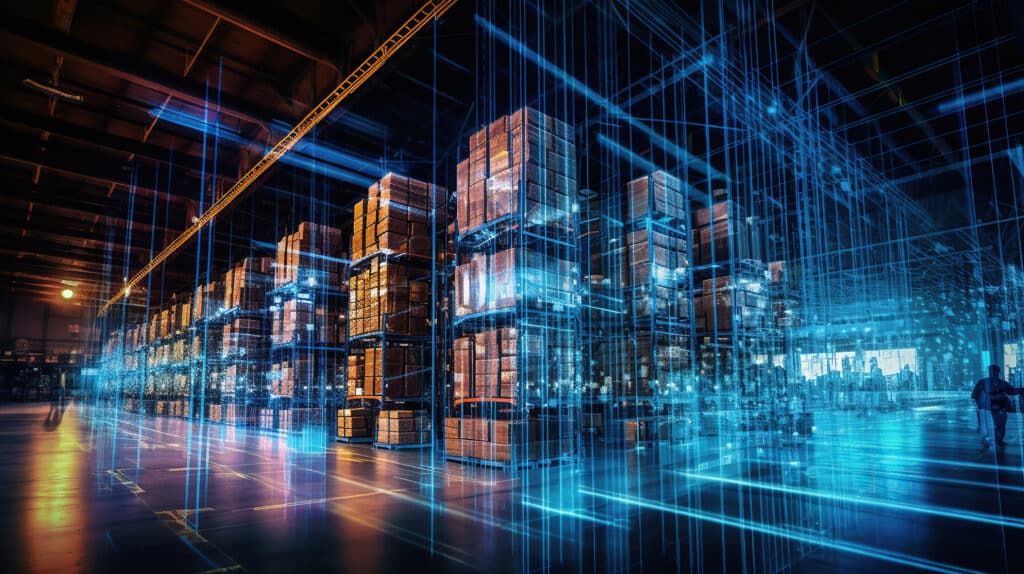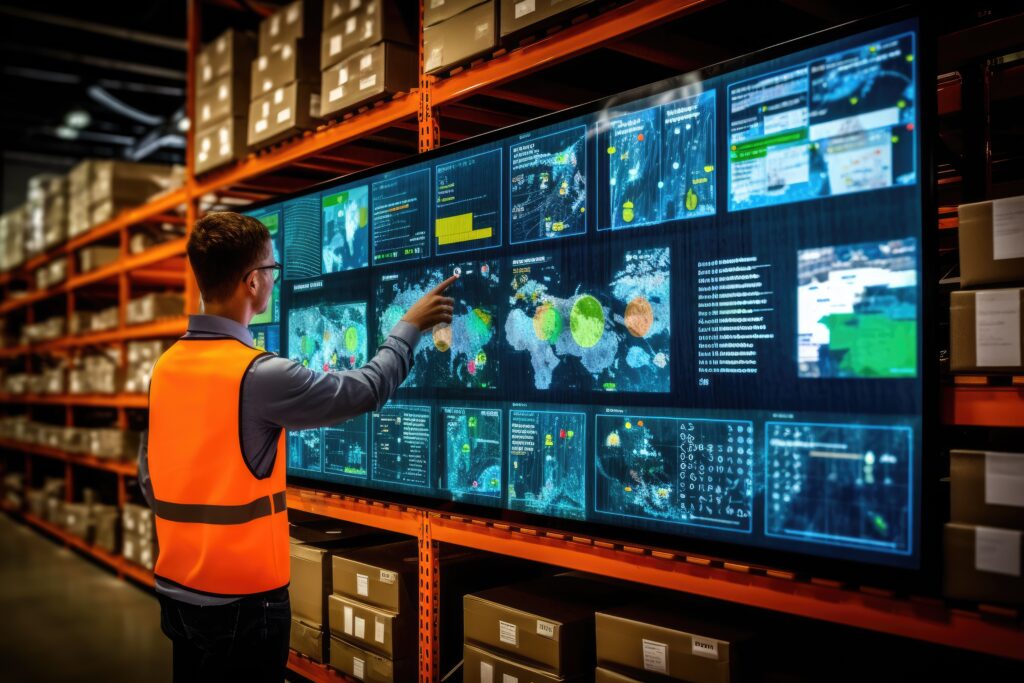Let’s be honest: Do you feel that the production and supply chain processes in your company are transparent and efficient enough? 90% of your colleagues would probably answer this question with “no”¹ and this is why real-time transparency becomes essential.
And for good reason: Despite the fact that production and logistics companies are working at full speed on their own digital transformation, there are still – or precisely because of this – new vulnerabilities that present companies with massive challenges.
From heterogeneous IT system landscapes to dynamic process chains and uncaptured side processes to tasks that still have to be performed manually – the list of potential weaknesses is long and costs companies efficiency and thus significant financial losses across the entire value chain every year.
In this blog post, we tackle some of the main reasons for the lack of transparency in process chains and highlight the importance of real-time transparency, based on the crucial three “W’s”: WHAT, WHERE and WHY. And as a magic ingredient, we add the “HOW“ as a way to solve the above-mentioned vulnerabilities once and for all.
Welcome to the vulnerabilities in your processes that you are likely to struggle with
Let’s start right where it hurts. Over the past few years, you have given a lot of thought to which processes you would like to digitize in your company and how to go about it. To do this, you’ve probably worked with software consultants and industry experts to look at a lot of systems – mostly stand-alone solutions – that can map certain parts of your value chain. In addition, there are legacy systems that have been implemented before and would be too time-consuming and costly to replace.
Now, you are using ERP, WMS and MES systems to plan and control processes in logistics, intralogistics, warehousing and on the shopfloor. The problem is: they are organized in a heterogeneous IT system landscape and therefore cannot represent the entire process chain in a transparent manner. Moreover, you have paid a lot of money for the various systems, only to find that the maximum degree of efficiency cannot be achieved.
In addition, there are increasingly dynamic and complex process chains to which new components must always be added. Vice versa, this means that you have to continuously – and more or less experimentally – develop and individualize the systems you use. Running costs are generated, but they don’t necessarily make your operations more transparent and efficient.
Apart from that, a weak point that every supply chain manager can tell you a thing or two about is the so-called “side processes“. These cannot be mapped in the existing systems at all, or only with a disproportionate amount of effort. This leads to loopholes in your value chain that cannot be eliminated.
Another painful fact is that systems are just as smart and accurate as the people handling it and feeding it with data input. In many cases this means manual input like scans or manual bookings on mobile devices, terminals or typically on the desktop.
Moreover, most companies are still a long way from a paperless environment. In addition to digital data input, analog documents must therefore also be handled. In most companies, employees digitize this data manually. But even though everyone knows that manual data input is a matter of discipline and training, mistakes naturally happen here. This leads to problems like early or late data entry or in the worst case no scanning or booking at all.
Where does all this end? Incorrect inputs result in poor resource planning. All together, this leads to noticeable inefficiencies. Not to mention the effort involved in correcting all these errors. Just think about the results of your last inventory. Differences in the annual inventory are the result of all uncovered data input failures made.

What real-time transparency enables you to do and how to achieve it
After all the weak point talk, here’s the good news: There is hope and it’s called “real-time transparency”. Imagine you had all the data for your planning that would be available in real time, 24/7, without gaps and 100% valid. Your planning would be a breeze and even if something goes wrong you could identify the source in no time and react quickly.
Imagine your co-workers in the warehouse or production could focus on their actual jobs instead of interrupting it to feed your management systems with data. They would be much more productive, ending up in a higher overall output and much less frustration.
So how do you get to this real-time transparency and the benefits that come with it? Before we talk about the “HOW”, you should first be aware of the WHAT, WHERE and WHY.
WHAT?
First, consider what will make your value chain more transparent. The simple answer is: seamless asset tracking. The question of “what” can be answered simply with “everything”. With the help of Auto-ID technologies like barcode or RFID as well as locating technologies like GPS, UWB and BLE, every asset can be turned into a “smart object”. No matter if material, orders, vehicles, handling units, load carriers etc. – the spatial position of all moving parts of your operation can now be identified and localized.
WHERE?
Let’s assume that you have provided all relevant assets with appropriate tracking technologies. Now let’s move on to the small but important word “seamless” and thus to the “where”. The answer to “where” should be: “everywhere”. A smart object should be able to identify and locate itself seamlessly across your entire site, whether indoor or outdoor. The granularity of locating depends on your requirements but everything is possible – from locating something at a given time at a certain place (point of interest logic) up to locating things in real-time down to 2 – 0.1 meters and distributed over your entire company premises (RTLS logic).
WHY?
Answering the question of “why” is the last missing link in the logic chain: WHAT (i.e. material) is moved WHERE (i.e. a storage location) because WHY. The question here is not why tracking makes sense, but why a particular business event was triggered. Business events are usually triggered by an ERP and WMS booking/scan. However, they can also be triggered by a so-called geofence event – that is, by the intelligent object simply entering or leaving a virtual space. These geofences and the events generated by them follow the same logic as the scanning/booking we all know – it triggers a process in our WMS or ERP system, but with the big difference that it happens automatically and we don’t see it actually happening. This is what we call location-based automation.

The big “How”: Leveraging transparency through location based automation
Most people think of “automation” in the context of industrial production or logistics as the use of robots, auto-store warehouses and conveyor lines. This is not wrong in general, but automation primarily refers to automating processes independent of the given infrastructure – wherever and however they happen or look like. This is the core of location-based automation.
In supply chain management, location based automation provides unprecedented levels of visibility and efficiency. When an asset enters or exits a defined geofence such as a warehouse or production site, specific automatic actions are triggered. For instance an incoming truck might prompt advance notifications to an AGV that helps with unloading. When the AGV delivers the asset to its storage position, the inventory management system will be updated with the latest stock information. And this is just one of many use cases location-based automation can be utilized for. Thus it plays a vital role in improving operational efficiency, reducing manual tasks, and enhancing transparency in the supply chain.
As an agile company, you naturally want to be able not only to map these processes smoothly, but also to optimize them ad-hoc. The prerequisite for this is, on the one hand, that the position of each asset is recorded in real-time and brought together centrally in a system.
And this is where it gets tricky: as mentioned at the beginning, companies usually use different systems to organize their supply chain or logistics. Even if they already work with location technologies – the hardware components and software solutions are often different and interoperability of the various ecosystems is usually not guaranteed. As a result, cross-process chain transparency is also lacking.
So how do you ensure you do not end up with dozens of different solutions blowing up the system landscape? How can you avoid internal interest conflicts? And how do you establish location-based automation without investing in your ecosystem over and over again?

Flowcate’s DeepHub harmonizes location data based on the omlox standard
Imagine being able to bundle all location data via one interface and manage it transparently via one dashboard using a uniform standard. This is possible with Flowcate’s DeepHub in combination with omlox, the world’s first open locating standard.
DeepHub is the premier omlox middleware solution, consuming indoor and outdoor location data from any technology and transforming it into standardized, georeferenced coordinates. This data is pushed to any type of IoT solution or application (ERP, WMS, MES etc.) through a single API. By harnessing the interoperability of the omlox standard, an IoT solution powered by the DeepHub is guaranteed to be technology and vendor-agnostic.
The DeepHub and omlox also solve the cost dilemma that companies have with different technology ecosystems: the open plug & play system allows a future-proof and scalable solution to be created without having to rebuild or replace the existing hardware infrastructure.
More process efficiency, less manual tasks, time and cost savings: This is why real-time transparency pays off
Real-time transparency and location-based automation simultaneously represent the greatest challenges and levers in today’s production and logistics.
In this article, we have described in detail the greatest weaknesses of non-transparent value chain processes. However, these are not impossible to overcome, because real-time location technologies are here to help, and their data can be merged via DeepHub and omlox.
This not only creates maximum process transparency, but also provides a harmonized tracking ecosystem that enables true automation and allows for real-time process optimization.
Read our article “5 hurdles to overcome when implementing RTLS” to learn more about the framework you need to create in your company for a successful implementation of real-time locating technologies and what you should specifically pay attention to.
